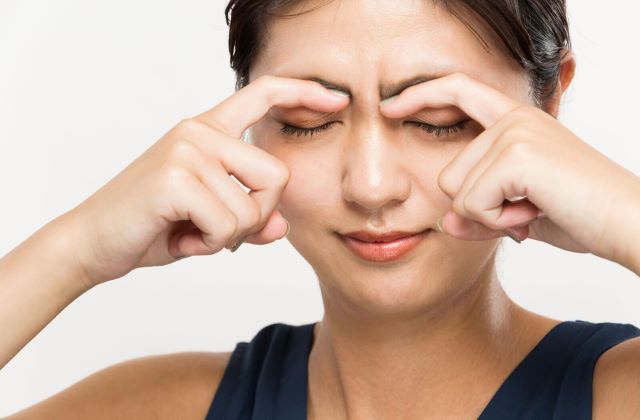Is Your Eyelid Blinking SOS? When to Seek Help for Twitching

Ever experienced that annoying little flutter in your eyelid? You’re not alone. Eyelid twitching, technically known as blepharospasm, is a common and often harmless occurrence that affects people of all ages. While generally temporary and resolving on its own, the persistent fluttering can be frustrating and raise concerns about underlying health issues. Let’s delve into the world of eyelid twitching, exploring its causes, potential complications, and effective management strategies.
Understanding the Flicker: Causes and Mechanisms
The delicate muscles surrounding your eyelids, the orbicularis oculi, are responsible for blinking and closing your eyes. Eyelid twitching occurs when these muscles contract involuntarily, causing a brief, often repetitive, fluttering sensation. While the exact cause remains elusive in some cases, several factors can trigger these unwanted twitches:
- Fatigue and Stress: A leading culprit, fatigue and stress can disrupt the delicate balance of neurotransmitters in your brain, leading to muscle imbalances and eyelid twitching.
- Caffeine and Alcohol: Excessive intake of caffeine and alcohol can act as stimulants, affecting your nervous system and triggering eyelid spasms.
- Eye Strain: Overexerting your eyes from prolonged screen time, reading in dim light, or dry eyes can irritate the ocular muscles and contribute to twitching.
- Nutritional Deficiencies: Deficiencies in magnesium, calcium, and vitamin B12 can interfere with nerve function and muscle control, potentially leading to eyelid twitching.
- Underlying Medical Conditions: In rare cases, eyelid twitching can be a symptom of neurological disorders like Parkinson’s disease, multiple sclerosis, or Bell’s palsy.
A Flicker or a Flare? When to Seek Medical Attention
While most eyelid twitches are benign and resolve within a few days or weeks, some instances warrant a doctor’s visit. Seek medical attention if:
- The twitching is persistent, lasting for several weeks or months.
- The twitching affects both eyelids and spreads to other facial muscles.
- The twitching is accompanied by redness, swelling, or pain in the eye.
- You experience vision changes like blurry vision or drooping eyelids.
- You have concerns about a potential underlying medical condition.
Taming the Twitch: Effective Management Strategies
Fortunately, several lifestyle modifications and home remedies can help manage and reduce eyelid twitching:
- Prioritize Sleep and Manage Stress: Aim for 7-8 hours of quality sleep and incorporate stress-reduction techniques like yoga, meditation, or deep breathing exercises.
- Limit Caffeine and Alcohol: Minimize your intake of stimulants and alcohol to avoid triggering muscle spasms.
- Rest Your Eyes: Take regular breaks from screens and give your eyes time to relax. Apply cool compresses to soothe irritated eyes.
- Practice Good Eye Hygiene: Maintain proper eye hygiene by washing your hands before touching your eyes and ensuring clean contact lenses.
- Dietary Adjustments: Ensure adequate intake of essential nutrients like magnesium, calcium, and vitamin B12 through diet or supplements.
Expert Insights: What the Specialists Say
Leading health experts emphasize the importance of a holistic approach to managing eyelid twitching. Dr. Robert W. Dodenhoff, a renowned neurologist at the Mayo Clinic, stresses the need for identifying and addressing underlying triggers like stress and fatigue. Dr. Jennifer L. Wong, an ophthalmologist at Harvard Medical School, recommends focusing on good eye hygiene and ensuring adequate sleep to keep eyelid muscles relaxed.
A 2019 study published in the Journal of Clinical Neurology and Neurosurgery found that mindfulness-based stress reduction techniques effectively reduced the frequency and severity of eyelid twitching in patients. Likewise, a 2020 research paper published in the journal Current Pain and Headache Reports highlighted the beneficial role of magnesium supplementation in managing chronic eyelid twitching.
The Final Blink: Embracing Calm Amidst the Flutter
Eyelid twitching, while often an annoyance, is rarely a cause for alarm. By understanding the potential triggers and implementing practical management strategies, you can gain control over these unwanted flutters and regain peace of mind. Remember, prioritize a healthy lifestyle, address underlying stressors, and seek medical advice if the twitching persists or worsens. With a little awareness and care, you can keep your eyelids blinking happily and your vision clear and focused.
I hope this comprehensive guide provides valuable insights into eyelid twitching and empowers you to navigate this common yet sometimes unsettling experience. By incorporating the expert advice and research findings, you can effectively manage these unwanted flutters and maintain optimal eye health.
FOR MORE INFORMATION & CONSULTATION VISIT: Divya Jyothi Eye Hospital, Kiresur Complex, Beside Axis Bank, Unkal Cross, PB Road, Hubballi-580031. Phone: 0836-2272345, 2272728, Email: [email protected]
Disclaimer: The information in this article is for general purposes only and should not be considered as medical advice. Consult a healthcare professional for personalized guidance. The authors and the platform are not liable for any reliance on the information herein.




